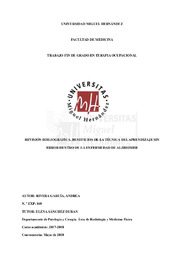Por favor, use este identificador para citar o enlazar este ítem:
https://hdl.handle.net/11000/26035Registro completo de metadatos
| Campo DC | Valor | Lengua/Idioma |
|---|---|---|
| dc.contributor.advisor | Sánchez Durán, Elena | - |
| dc.contributor.author | Rivera García, Andrea | - |
| dc.contributor.other | Departamentos de la UMH::Patología y Cirugía | es_ES |
| dc.date.accessioned | 2022-03-01T08:03:16Z | - |
| dc.date.available | 2022-03-01T08:03:16Z | - |
| dc.date.created | 2018-05-08 | - |
| dc.identifier.uri | http://hdl.handle.net/11000/26035 | - |
| dc.description.abstract | Introducción: los problemas de memoria en las personas con enfermedad de Alzheimer (E.A) comien- zan en memoria explícita, con fallos en la memoria episódica reciente y conforme la enfermedad pro- gresa, en la memoria remota. Los pacientes con E.A muchas veces aprenden del error y lo repiten con- tinuamente, sin lograr recordar la información correcta. La técnica de Aprendizaje sin Error (AsE) o Errorless Learning (E.L) se basa en el conocimiento de que las respuestas autogenera das crean una hue- lla mnésica a través de los procesos de memoria implícita y que además éstas se mantienen en la memo- ria. Por todo ello se presenta como una técnica de utilidad en E.A. Objetivo: determinar la eficacia de la técnica de Aprendizaje sin Err or (AsE) en los problemas de me- moria de la E.A. Material y método: se realizó una búsqueda de artículos siguiendo una serie de criterios de inclusión y exclusión en las bases de datos Medline, Science Direct y Otseeker. Resultados: los artículos obtenidos en la búsqueda realizada han sido 15. En los estudios podemos encontrar algunos en los que se compara el E.L con otras técnicas, otros centrados únicamente en valorar la eficacia del E.L y estudios que concluyen la necesidad de realizar una mayor investigación sobre dicho tema. Conclusión: aunque la mayoría de artículos confirman la eficacia del EL en E.A, sería necesario la realización de nuevos estudios que apoyen estos resultados y además incorporar para futuras investiga- ciones la figura del T erapeuta Ocupacional. | es_ES |
| dc.description.abstract | Introduction: memory problems in people with Alzheimer's disease (A.D) begin in explicit memory, with recent episodic memory failures and with the disease progressing, in remote memory. Patients with A.D often learn from the error and repeat it continuously, without being able to remember the correct information. The technique of Learning without errors (E.L) or Aprendizaje sin Error (AsE) is based on the knowledge that self-generated responses create a mnesic trace through the processes of implicit me-mory and that also remain in memory. For all this it is presented as a useful technique in A.D. Objective: to determine the effectiveness of the technique of Errorless Learning (E.L) in memory pro-blems of A.D. Material and method: an article search was carried out following a series of inclusion and exclusion criteria in the Medline, Science Direct and Otseeker databases. Results: the articles obtained in the search have been 15. In the studies we can find some in which the E.L is compared with other techniques, others focused only on assessing the effectiveness of E.L and studies that conclude the need for further research on said theme. Conclusion: although most articles confirm the efficacy of E.L in A.D, it would be necessary to carry out new studies that support these results and also to incorporate the figure of the Occupational Therapist for future research. | es_ES |
| dc.format | application/pdf | es_ES |
| dc.format.extent | 30 | es_ES |
| dc.language.iso | spa | es_ES |
| dc.publisher | Universidad Miguel Hernández de Elche | es_ES |
| dc.rights | info:eu-repo/semantics/openAccess | es_ES |
| dc.rights.uri | http://creativecommons.org/licenses/by-nc-nd/4.0/ | * |
| dc.subject | Alzheimer | es_ES |
| dc.subject | aprendizaje sin error | es_ES |
| dc.subject.other | CDU::6 - Ciencias aplicadas | es_ES |
| dc.title | Revisión bibliográfica. Beneficios de la técnica del aprendizaje sin error dentro de la enfermedad de Alzheimer | es_ES |
| dc.type | info:eu-repo/semantics/bachelorThesis | es_ES |

Ver/Abrir:
TFG. Rivera García, Andrea..pdf
1,03 MB
Adobe PDF
Compartir:
 La licencia se describe como: Atribución-NonComercial-NoDerivada 4.0 Internacional.
La licencia se describe como: Atribución-NonComercial-NoDerivada 4.0 Internacional.
.png)